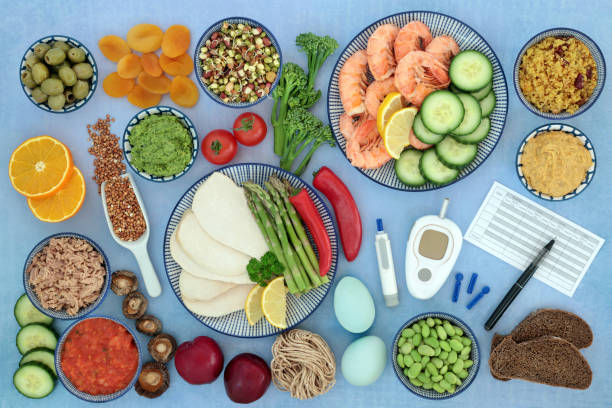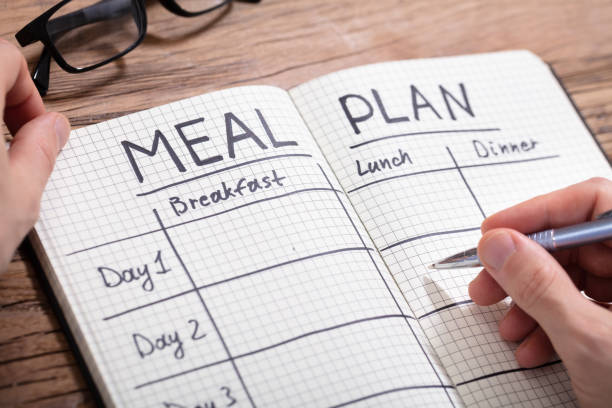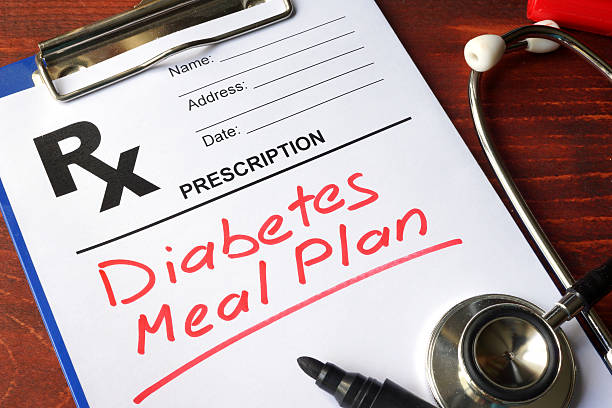Why Meal Planning Matters for Diabetes
Managing diabetes means paying close attention to the foods you eat every day. A well-thought-out meal plan can help you:
- Keep blood sugar levels stable – Avoid sudden spikes and crashes that can affect your health.
- Boost energy and overall well-being – Eating balanced meals supports steady energy throughout the day.
- Make healthier food choices – Planning ahead reduces stress and helps you pick the right foods.
- Maintain a healthy weight – Portion control and balanced meals support weight management.
- Lower the risk of complications – A diabetes-friendly diet can help prevent heart disease, nerve damage, and other health issues.
By preparing your meals in advance, you can enjoy food that is not only nutritious and delicious but also supports better blood sugar control.

How to Create a Diabetes-Friendly Meal Plan
Meal planning for diabetes doesn’t have to be complicated. Follow these steps to set yourself up for success.
1. Focus on Balanced Meals
Each meal should include a mix of:
- Lean proteins – Choose options like chicken, fish, tofu, eggs, or lean beef to support muscle health and keep you feeling full.
- Healthy fats – Add heart-friendly fats from sources like avocado, nuts, olive oil, and flaxseeds to help with nutrient absorption.
- High-fiber carbohydrates – Opt for fiber-rich foods such as vegetables, whole grains, legumes, and berries to slow down sugar absorption and support digestion.
This combination helps regulate blood sugar levels, keeps energy levels steady, and promotes overall health. Balanced meals also reduce cravings and prevent sudden spikes or crashes in blood sugar.lps slow digestion, prevents blood sugar spikes, and keeps you feeling full longer.
2. Choose Low-Glycemic Foods
The glycemic index (GI) measures how fast a food raises blood sugar. Foods with a low GI digest slowly, preventing sharp spikes and crashes. Eating more low-GI foods helps keep blood sugar stable and supports better diabetes management. Some great options include:
- Non-starchy vegetables – Broccoli, spinach, peppers, zucchini, and kale are packed with fiber and nutrients.
- Whole grains – Choose quinoa, barley, brown rice, bulgur, and whole wheat pasta instead of refined grains.
- Beans and lentils – Chickpeas, black beans, and kidney beans provide fiber and protein to slow digestion.
- Fruits – Berries, apples, pears, oranges, cherries, and peaches are naturally sweet but won’t spike blood sugar.
- Dairy and alternatives – Unsweetened almond milk, Greek yogurt, and cottage cheese offer protein without added sugar.
For a complete list of GI values, visit the American Diabetes Association or look for GI charts to help guide your food choices.
3. Control Portion Sizes
Eating too much—even of healthy foods—can cause blood sugar spikes. Portion control helps you manage your blood sugar while still enjoying balanced meals. Try these simple tips:
- Fill half your plate with non-starchy vegetables – Leafy greens, peppers, cucumbers, and cauliflower add fiber and nutrients.
- Keep protein to a quarter of your plate – Lean meats, fish, eggs, tofu, or beans provide energy and keep you full.
- Limit carbs to a small portion – Stick to a serving about the size of your fist to prevent blood sugar spikes.
- Use measuring cups and spoons – This helps track portions of grains, dairy, and fats.
- Try a food scale – Weighing food ensures accurate portion sizes, especially for carbs and proteins.
- Use a smaller plate – A 9-inch plate can make portions look bigger, helping you feel satisfied with less.
Being mindful of portion sizes allows you to enjoy a variety of foods while keeping your blood sugar in check.dditionally, eating slowly and paying attention to hunger cues can prevent overeating.
4. Plan Ahead and Prep Meals
Having healthy meals ready makes it easier to stick to a diabetes-friendly diet and avoid unhealthy last-minute choices. Try these simple meal prep strategies:
- Batch cook proteins – Grill chicken, bake fish, or prepare turkey meatballs to use in different meals.
- Chop veggies in advance – Store pre-cut vegetables for quick salads, omelets, stir-fries, or snacks.
- Prepare grab-and-go snacks – Keep healthy options like almonds, Greek yogurt, hummus with carrots, or hard-boiled eggs on hand.
- Pre-portion meals – Divide meals into containers for easy, balanced eating throughout the week.
- Freeze extra meals – Store leftovers for busy days when cooking isn’t an option.
Planning ahead saves time, reduces stress, and helps maintain steady blood sugar levels by ensuring healthy choices are always available.
5. Stay Hydrated
Proper hydration is essential for blood sugar control. When you’re dehydrated, your blood sugar levels can rise, making diabetes management harder. To stay hydrated, follow these tips:
- Drink plenty of water – Aim for at least 8 glasses a day, or more if you’re active.
- Try herbal teas or infused water – Add lemon, cucumber, mint, or berries for a refreshing, sugar-free drink.
- Avoid sugary beverages – Sodas, energy drinks, and excessive fruit juice can cause blood sugar spikes.
- Be mindful of coffee choices – If you drink coffee, limit added sugars, syrups, and creamers to prevent hidden sugar intake.
Staying hydrated helps with digestion, energy levels, and blood sugar stability, making it a key part of your diabetes meal plan.

Sample Diabetes Meal Plan
Here’s a simple and balanced meal plan to help you maintain steady blood sugar levels while enjoying delicious, nutrient-rich foods:
Breakfast:
- Scrambled eggs with spinach and a slice of whole-grain toast
- A small serving of berries (blueberries, raspberries, or strawberries) for fiber and antioxidants
- Black coffee or herbal tea (without added sugar)
Mid-Morning Snack:
- Cottage cheese mixed with flaxseeds and sliced peaches for protein and healthy fats
- A handful of walnuts for heart-healthy omega-3s
Lunch:
- Grilled chicken salad with mixed greens, avocado, and a light vinaigrette dressing
- A side of quinoa or barley for fiber and slow-digesting carbs
- Sparkling water with a splash of lime instead of sugary drinks
Afternoon Snack:
- A handful of almonds and an apple for a mix of protein, fiber, and healthy fats
- A boiled egg for extra protein and satiety
Dinner:
- Baked salmon for lean protein and omega-3 fatty acids
- Roasted Brussels sprouts and brown rice for fiber and sustained energy
- A small mixed greens salad with olive oil dressing
- A glass of water with lemon for hydration and digestion
Evening Snack:
- Greek yogurt sprinkled with cinnamon and a few walnuts for gut health and blood sugar control
- A small square of dark chocolate (at least 70% cocoa) for a satisfying, antioxidant-rich treat
This meal plan is designed to provide steady energy, balanced nutrients, and controlled portions, making it a great starting point for diabetes management.
Smart Grocery Shopping Tips
Meal planning starts at the grocery store. Making smart choices while shopping helps you stick to a diabetes-friendly diet and avoid unhealthy temptations. Follow these simple tips:
- Stick to the perimeter – Fresh produce, lean proteins, and dairy are usually found along the store’s outer aisles.
- Read food labels – Check for hidden sugars, unhealthy fats, and high sodium content in packaged foods.
- Buy in bulk – Stock up on healthy pantry staples like nuts, whole grains, beans, and lentils to save money and always have good options on hand.
- Choose frozen vegetables – They are just as nutritious as fresh and last longer, making them a great backup for meal prep.
- Limit processed foods – Many packaged snacks and convenience meals contain added sugars, refined carbs, and unhealthy fats that can spike blood sugar.
Planning your grocery list in advance and making healthy swaps can make meal planning easier while keeping your blood sugar in check.

Common Mistakes to Avoid
When meal planning for diabetes, be mindful of these common mistakes that can make blood sugar harder to control:
- Skipping meals – Going too long without eating can lead to blood sugar fluctuations and cause overeating later. Aim for regular, balanced meals throughout the day.
- Eating too many carbs – Even healthy carbs should be eaten in moderation. Choose whole, unprocessed carbs like quinoa, brown rice, and legumes instead of refined options.
- Not reading labels – Some foods marketed as “healthy” may have hidden sugars, unhealthy fats, or high sodium. Always check the nutrition facts before buying.
- Forgetting to adjust portions – Your portion needs change based on activity levels, weight, and medication. Be mindful of serving sizes to keep blood sugar stable.
- Eating out too often – Restaurant meals often contain excess salt, sugar, and unhealthy fats. When dining out, opt for grilled proteins, salads, and vegetable-based sides.
- Not getting enough fiber – Fiber slows digestion, helps control blood sugar, and supports gut health. Include fiber-rich foods like vegetables, whole grains, beans, and berries in your meals.
By avoiding these pitfalls, you can make meal planning more effective, balanced, and diabetes-friendly.
Take Control of Your Health Today!
Meal planning is a powerful tool for managing diabetes and maintaining a healthy lifestyle. By making smart food choices and preparing meals in advance, you can:
- Keep blood sugar levels stable – Balanced meals help prevent spikes and crashes.
- Enjoy delicious, nutritious foods – Eating well doesn’t mean sacrificing flavor.
- Reduce stress around mealtime – Planning ahead makes it easier to stick to healthy habits.
- Lower the risk of complications – A well-structured diet supports heart health, digestion, and overall well-being.
Start today by choosing diabetes-friendly ingredients, prepping meals ahead of time, and staying consistent. Small changes can lead to big improvements in your health and quality of life!
What are your favorite diabetes-friendly meals? Share your thoughts in the comments below!

